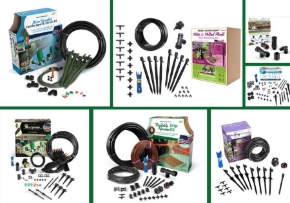Drip Irrigaiton Is?
Many people have heard of Drip Irrigation, but not everyone knows what it means, where it came from, or how easy it is to implement into your landscapes and gardens. I wanted to write a quick bit about it and share how awesome this method of irrigation can be for your plants.
What is Drip Irrigation?
Drip irrigation is an irrigation method that saves water and fertilizer by allowing water to drip slowly to the roots of plants, either onto the soil surface or directly onto the root zone, Basically, it means that you can control where the water goes - being extremely efficient, effective and environmentally cautious in your plant development.
Where did it come from?
Drip methods of watering plants where water was scarce have been around for centuries - from ancient times where clay pots were filled with water and allowed to seep into the soil to modern methods that involve poly and vinyl tubing and pressure compensated drippers for a specific flow rate for plants. The more modern version of drip was developed after World War II, and it was used in arid climates to grow crops. That method of drip irrigation is very similar to what is used today. With technology leading the way in water conservation, Drip Irrigation is improving constantly, allowing for more water saving and better irrigation of plants then ever. Electronic water timers and soil moisture sensors can be added to drip systems to make them extremely effective at using water with little or no waste, making Drip Irrigation the most environmentally friendly way to irrigate, outside of natural rain storms.
Installing Drip Irrigation?
When most people think of installing irrigation, pictures of long hot hours in the sun, digging ditches, laying pipes in the ground, and using tools to cut, manipulate and arrange them, come to mind. All of that is how underground irrigation is installed. Installing drip irrigation is actually really easy by comparison. For home garden and landscape use, many times all that is required is a faucet hook-up somewhere near where the irrigation is to be laid. This makes installation really fast and efficient for homeowners to set up. The most simple of Mister Landscaper's Drip Irrigation Kits is set up by attaching it to an outdoor faucet like a hose and running a line of poly to the location where the irrigation is needed. The only tool really needed is a pair of scissors, and maybe a small hammer if you have hard ground.
If a homeowner has underground irrigation, it is even easier to install Drip or Micro Irrigation. For instance, one can easily attach adapters to PVC pipes for existing irrigation and then run lines to the areas where they would like to have drip. Most set up of Drip or Micro Irrigation can take less then an hour to do and can save over 50% of the water used in traditional irrigation methods.
So, if you want to save time, save money, water your plants the best way possible, and most importantly save water for generations to come, Drip Irrigation and Micro Irrigation is the way to go.
Does Mister Landcaper have the best Drip Irrigation on the planet, Well, we think we do.
Have an awesome day!

















